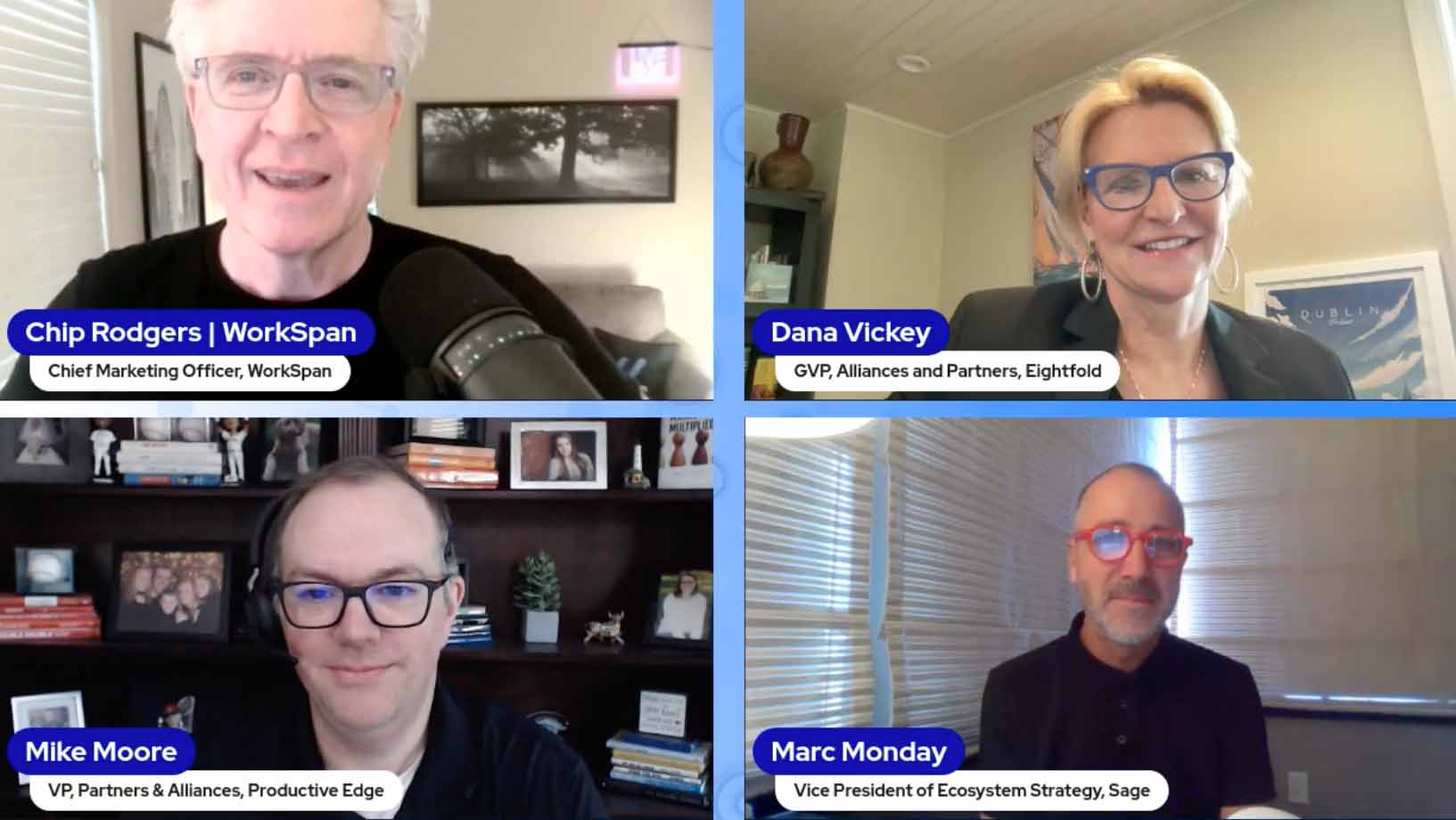
In today’s world partnerships have become an essential driver of growth and innovation. While many organizations solely focus on external partnerships overlooking the importance of internal stakeholder alignment that can hinder/delay the potential for future success. Organizations are now realizing that their internal stakeholders can be powerful collaboration partners and how internal alignment can pave the way for successful partnerships.
We once again gathered an expert panel of ecosystem pioneers to get their perspective, best practices and valuable tips on this important topic “How to Align Your Entire Company Around Partnerships”.
Our panelists:
- Mike Moore, VP Strategic Partnerships, Productive Edge
- Dana Vickey, Global Vice President, Alliances, Partners and Channel, Eightfold
- Marc Monday, Vice President, Global Strategic Partnerships, Sage
Let’s get into the conversation!

Transform partnerships from an add-on to a core part of your company's strategy
Our panelists were in complete agreement that the integration of partnerships into an organization's overall strategy is not merely a suggestion, but an absolute necessity for achieving success. Their insights shed light on three pivotal factors to consider:
- Shift the language and broaden the perspective: Move away from channel-centric terminology and instead focus on indirect sales or routes to market. This expands the conversation to encompass ecosystem-building and the potential for cross-selling, upselling, and influence.
- Demonstrate tangible value and personalize the message: Showcase the benefits of partnerships to individual stakeholders by highlighting professional development opportunities, financial incentives, and improved market value. Personalizing the message ensures alignment and helps individuals understand how partnerships directly benefit them and their teams.
- Start small, prove success, and engage key internal stakeholders: Begin with low-risk partnerships and friendly collaborations to demonstrate the positive impact and generate internal buy-in. Engage finance to show the return on investment and lower cost-to-serve, while aligning legal and compliance teams to address potential roadblocks and ensure a supportive environment for partnership initiatives.
Role of executive leadership in fostering a partnership-focused culture within an organization
Leadership plays an important role in fostering a partnership focused culture within an organization. It is important to establish a clear understanding of expectations when introducing a new role. Executives may bring their expectations based on their previous experience in the industry they have worked in the past. But it’s important to understand that those expectations align with the present situation.
For successful partnerships it is important to set clear expectations, align goals and timelines and effectively communicate with teams and partners. By involving leadership in meetings and educating them about the partner ecosystem , executives gain exposure and understand the value, metrics and timeframes involved. This enables leaders to manage partnerships as business leaders by setting right expectations and avoiding misalignments that may arise from different perspectives.
One of the panelists provided important advice. He said that when engaging in business development and signing contracts with new partners, one should not boast prematurely. Better to wait until actual deals are booked before sharing the news. This approach will relieve unneeded pressure and allows the tangible results to demonstrate the success of the partnership before openly discussing it.
How do you build cross-functional partnerships within your company, and what impact does that have on external partnerships
Partnerships are a team effort involving multiple functions in an organization. When celebrating a significant win, it's important to recognize the effort and give credit to the entire team's contributions rather than just the partner account manager. This sense of inclusiveness fosters a desire to do more and be involved.
- Set realistic expectations early on in the partnership journey, as waiting until after securing a deal can lead to detrimental outcomes. Building repeatability with partners involves effective interlocking and navigating through various dynamics and discussions to ensure consistent success.
- Have a value proposition and a messaging for each audience: When building partnerships it is important to understand the goals and objectives of each cross-functional team in the organization. Rather than approaching them with complex solutions , it is more effective to present simplified and value driven propositions that can make their business better, faster, stronger and more cost-effective.
- Drive alignment & clarity: Use a collaboration roadmap to outline goals, roles, impacts and next steps for each team. Continuously refine it based on feedback from each discussion. This will help to provide governance and guidance throughout the process, ensuring everyone remains focused and aligned
Have a well defined process, internal communication and avoid overcommitment. Once successful outcomes are achieved highlight the collaborative efforts of the team.
Identifying and managing partnership detractors
For building successful partnerships it is important to identify and manage those in the organization that might not support partnerships (detractors). These detractors can be individuals or groups who express resistance towards alliances. The best way to manage partnership detractors is to have defined critical metrics and report on metrics to clearly show the value of partnering in black and white.
As channel professionals, it is essential to define these metrics ourselves rather than relying solely on leadership to set them for us. Educating the organization about the signals of alignment and success in the partnership helps create a shared understanding. Having a communication plan and regularly revisiting the established metrics ensures everyone remains focused and connected to the overall mission.
Additionally, investments in tools and systems that facilitate partner management can help streamline processes and enhance performance. By approaching partnership management strategically and measuring the right indicators, we can navigate detractors effectively and drive successful outcomes.
Panelists advice for organizational alignment
- Embrace digital channels: Recognize that a significant majority (around 78%) of customer buying decisions are made digitally before entering the sales pipeline. Utilize marketing strategies and diverse data sources to effectively engage customers in their preferred digital spaces.
- Understand partner motivations: When forming alliances, empathize with your partners and seek to understand their motivations and goals. This understanding will enable you to build strong partnerships by aligning with their organizational objectives.
- Select partners strategically: Choose partners based on the value they bring to your customers and services, rather than pursuing an excessive number of partnerships. Focus on partners who can contribute significantly to achieving mutual success and demonstrate a commitment to addressing your customers' needs.
Conclusion
Internal stakeholder alignment is important for driving successful partnerships. Organizations must include partnerships in their overall strategy. Involving executives and building cross-functional collaborations within the company are important.
Links & Resources
- Learn more about how WorkSpan helps customers accelerate their ecosystem flywheel through Co-selling, Co-innovating, Co-investing, and Co-marketing.
- Subscribe to the Ecosystem Aces Podcast on Apple Podcast, Spotify, Stitcher, and Google Podcast.
- Find insightful articles on leading and getting the most out of your partner ecosystem on the WorkSpan blog.
- Download the Best Practices Guide for Ecosystem Business Management
- Download the Ultimate Guide for Partner Incentives and Market Development Funds
- To contact the host, Chip Rodgers, with topic ideas, suggest a guest, or join the conversation about modern partnering, he can be reached on Twitter, LinkedIn, or send Chip an email at: chip@workspan.com
Heading
Heading 1
Heading 2
Heading 3
Heading 4
Heading 5
Heading 6
Lorem ipsum dolor sit amet, consectetur adipiscing elit, sed do eiusmod tempor incididunt ut labore et dolore magna aliqua. Ut enim ad minim veniam, quis nostrud exercitation ullamco laboris nisi ut aliquip ex ea commodo consequat. Duis aute irure dolor in reprehenderit in voluptate velit esse cillum dolore eu fugiat nulla pariatur.
Block quote
Ordered list
- Item 1
- Item 2
- Item 3
Unordered list
- Item A
- Item B
- Item C
Bold text
Emphasis
Superscript
Subscript





.png)